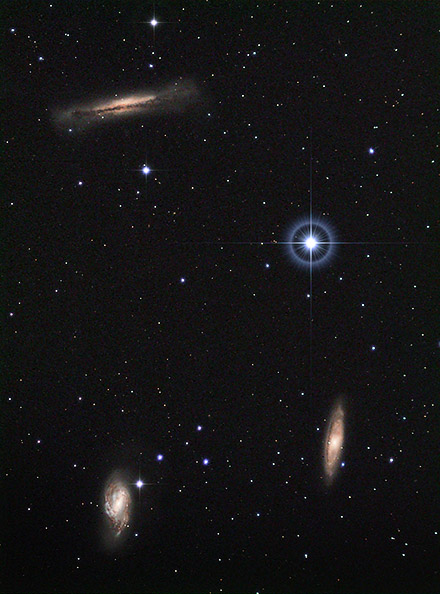|
5/30/2011. Two deep exoplanet transits occur tonight. The ingress of the first may be lost to the pines, but egress should be near the zenith. The second transit, an even deeper one, occurs late but will be well placed. In the twilight, I pulled the cover off the telescope, turned on power, requested "resume from park," initialized the computer, requested a slew to Regulus, and found the star on both the guide and imaging chips. I tweaked the aim of the telescope to center the star and recalibrated; re-centered the star on the guide chip using the guide 'scope's collimating rings. Ten minutes. Then from my office computer I waited for the end of astronomical twilight while watching to see if the Peltier cooler could get the chip down to -20°C. The air is 77°F after a high this afternoon in the lower 90's, and the air is humid. Dewpoint is 71°F, so the hair dryer may get a workout tonight. I'm excited! I've never taken aim at the planet of another star with the expectation of "seeing" it before. It seems that it's been only a few years since Sheldon Cohen, David Latham, and I enthused about the bare possibility of detecting such a thing (using radial velocity data) at the Falafel Hut in Knoxville (it's been almost 20 years!). And it's been only seven or eight since I showed Judith 55 Cancri in the eyepiece not long after its first planet was found. That was a characteristically esoteric astronomical sight: this is the sun of another world; we can't hope to see that world, but knowing that there is a place where that unassuming star is a sun in some planet's sky transforms an otherwise ordinary view into something wonderful. Tonight I expect to detect the shadows of two hot Jupiters.
First, XO-1 b, in Corona Borealis casts a 17 mmag shadow from its 11.3 magnitude sun starting at 10:31PM. Bird feeder pine will block the start. Egress should be well placed. Then TrES-3 b in Hercules crosses its 12.4 magnitude sun (a 29 mmag event) starting at 3:33 AM, perfectly placed from beginning to end. I started the night with an imaging sequence of M3. The cluster lies at almost exactly the same declination as XO-1 but leads it by 2h20m. XO-1 b is a slow transit; if I pick it up near mid-transit with 60 - 90 second exposures, there will be plenty of data to play with. TrES-3, later in the night, is much faster and slightly dimmer. The full event should be well presented high in the NW sky. I hope to start a sequence before the event begins and let the telescope take data in shorter gulps unattended. After M3 and before XO-1, I'll gather flats and darks for everything. Flats and darks in the can, XO-1 centered, guider recalibrated (just in case) and data coming in. 60s with the L filter is way too bright (58,000 adu) but I don't want to expose much shorter. So I rotated the red filter into play and settled on a 100-frame sequence of 90s exposures which yield a brightness well within the linear response range of the ST2000XM (18,000 adu). Here's a graph of the egress of XO-1 prepared using Maxim DL after calibrating 81 images and averaging them into 20 groups of four. Observations began a few minutes prior to mid-transit as the star cleared the pine canopy and continued for some time after the predicted end of the transit. The shaded area represents the interval when the transit was predicted to be in progress; the darker horizontal lines are seperated by the predicted transit depth. Don't worry about the magnitude scale; it depends entirely on the brightnesses I assign to my reference star(s) and for differential photometry those numbers might as well be arbitrary.
The shadow of a distant world: the end of an exo-planet transit.
For TrES-3, I restored the L-filter and slightly defocused the telescope to lower the maximum adu's and spread the light across adjacent pixels. With 60s exposures, I was getting on the order of 15,000 adu for this +/- 12.3 magnitude star. In the morning, I discarded the frames lost to dawn and calibrated the remaining 150 frames. I averaged them in groups of 5 and used Maxim DL to do differential photometry on the resulting 30 images. Here's the target field and a preliminary curve using Excel:
Exo-planet TrES-3 b transits its sun, a star in Hercules.
The shaded area represents the predicted transit. Tossing a few outliers would help. Making use of an artificial star and better use of available reference stars would help, too. Note that there's a pronounced upward slant to the data originating from... what? Normalizing for that would produce a more classical curve. Photometric analysis and I remain pretty good strangers. In preparing the photographic view, I saw that calibration of the frames for TrES-3 could be better. Much to learn, but now that I know these events are observable, there's more reason than ever to learn it. All in all not a bad start. Just a few years ago, the existence of planets around distant stars was a matter of conjecture. Last night I "saw" two of them using a small refractor in my backyard. That will do for today.
5/31/2011. Half a lifetime ago, 35 years?, George W. Kelley, Jr., introduced me to the Trio in Leo through an 8-inch reflector in his roll-off roof observatory beside the Middle Fork of the Holston River. The sight remains firmly fixed among my top 10 astronomical memories. [GWK says it was likely March 1971; time sure flies...] So today, with the Trio nicely positioned over the pines in the SW sky, I thought I'd point the 5-inch refractor in its direction:
The Trio in Leo
|
:: top ::
© 2011, David Cortner




